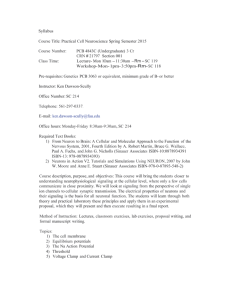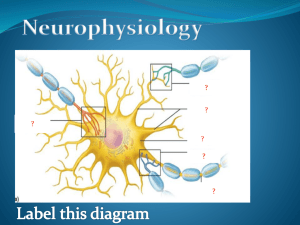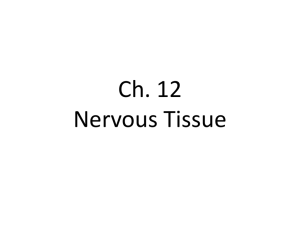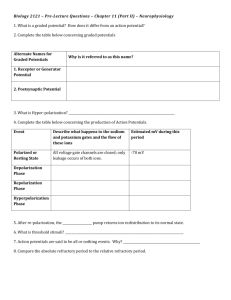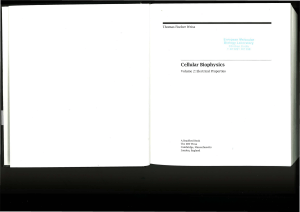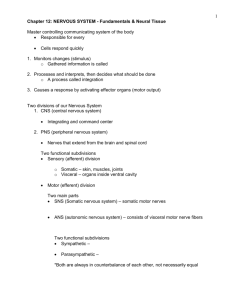Lecture 6
advertisement
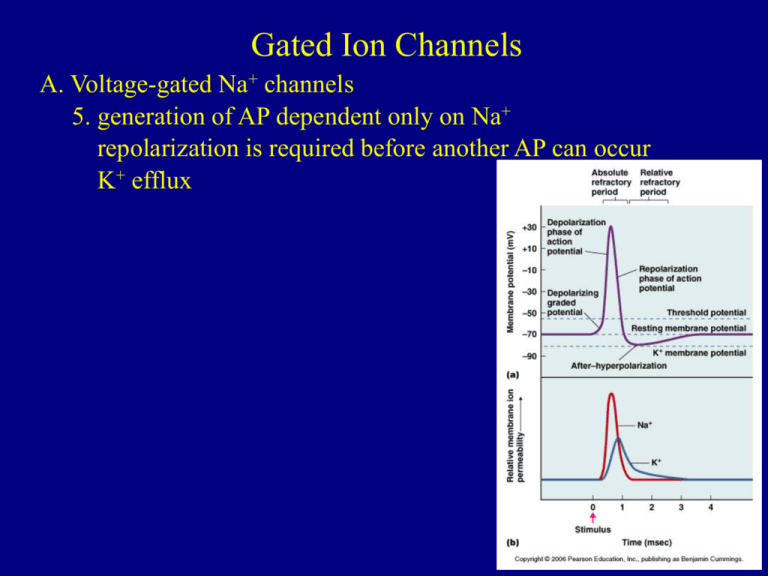
Gated Ion Channels A. Voltage-gated Na+ channels 5. generation of AP dependent only on Na+ repolarization is required before another AP can occur K+ efflux Gated Ion Channels A. Voltage-gated Na+ channels 6. positive feedback in upslope a. countered by reduced emf for Na+ as Vm approaches ENa b. Na+ channels close very quickly after opening (independent of Vm) Gated Ion Channels B. Voltage-gated K+ channels 1. slower response to voltage changes than Na+ channels 2. gK increases at peak of AP Gated Ion Channels B. Voltage-gated K+ channels 3. high gK during falling phase decreases as Vm returns to normal channels close as repolarization progresses Gated Ion Channels B. Voltage-gated K+ channels 4. hastens repolarization for generation of more action potentials Does [Ion] Change During AP? A. Relatively few ions needed to alter Vm B. Large axons show negligible change in Na+ and K+ concentrations after an AP. Potential Transmission A. Electrotonic 1. graded 2. receptor (generator) potentials Potential Transmission a. stimulus, then ∆ Vm b. electrical signal spreads from source of stimulus c. problem: no voltage-gated channels here d. signal decay “passive electrotonic transmission” Potential Transmission A. Electrotonic 3. good for only short distances 4. might reach axon hillock - that’s where voltage-gated channels are - where action potentials may be triggered Potential Transmission B. Action potential 1. propagation without decrement 2. to axon terminal Synaptic Transmission Synaptic Transmission A. Presynaptic neuron 1. neurotransmitter (usually) 2. synaptic cleft Synaptic Transmission B. Postsynaptic neuron 1. bind neurotransmitter 2. postsynaptic potential (∆ Vm) 3. may trigger action potential on postsynaptic effector Synaptic Transmission C. Alternation of graded and action potentials Intraneuron Transmission A. All neurons have electrotonic conduction (passive) B. Cable properties 1. determine conduction down the axon process 2. some cytoplasmic resistance to longitudinal flow 3. high resistance of membrane to current “but membrane is leaky” Intraneuron Transmission C. Nonspiking neurons 1. no APs 2. local-circuit neurons 3. still release neurotransmitter 4. vertebrate CNS, retina, insect CNS 5. are very short with increased Rm Intraneuron Transmission A. All neurons have electrotonic conduction (passive) B. Cable properties 1. determine conduction down the axon process 2. some cytoplasmic resistance to longitudinal flow 3. high resistance of membrane to current “but membrane is leaky” Intraneuron Transmission C. Nonspiking neurons 1. no APs 2. local-circuit neurons 3. still release neurotransmitter 4. vertebrate CNS, retina, insect CNS 5. are very short with increased Rm Intraneuron Transmission D. Propagation of action potentials 1. ∆ Vm much larger than threshold - safety factor Intraneuron Transmission D. Propagation of action potentials 2. spreads to nearby areas - depends on cable properties - inactive membrane depolarized by electrotonically conducted current Intraneuron Transmission D. Propagation of action potentials - K+ efflux behind region of Na+ influx Intraneuron Transmission D. Propagation of action potentials 3. unidirectional a. refractory period b. K+ channels still open Intraneuron Transmission D. Propagation of action potentials 4. speed a. relates to axon diameter and presence of myelin b. axon diameter, speed of conduction Intraneuron Transmission E. Saltatory conduction 1. myelination a. Rm , Cm b. the more layering, the greater the resistance between ICF and ECF Intraneuron Transmission E. Saltatory conduction c. charge flows more easily down the axon than across the membrane Intraneuron Transmission E. Saltatory conduction 2. nodes of Ranvier a. internodes (beneath Schwann cells or oligodendrocytes) b. nodes are only exit for current c. only location along axon where APs are generated
